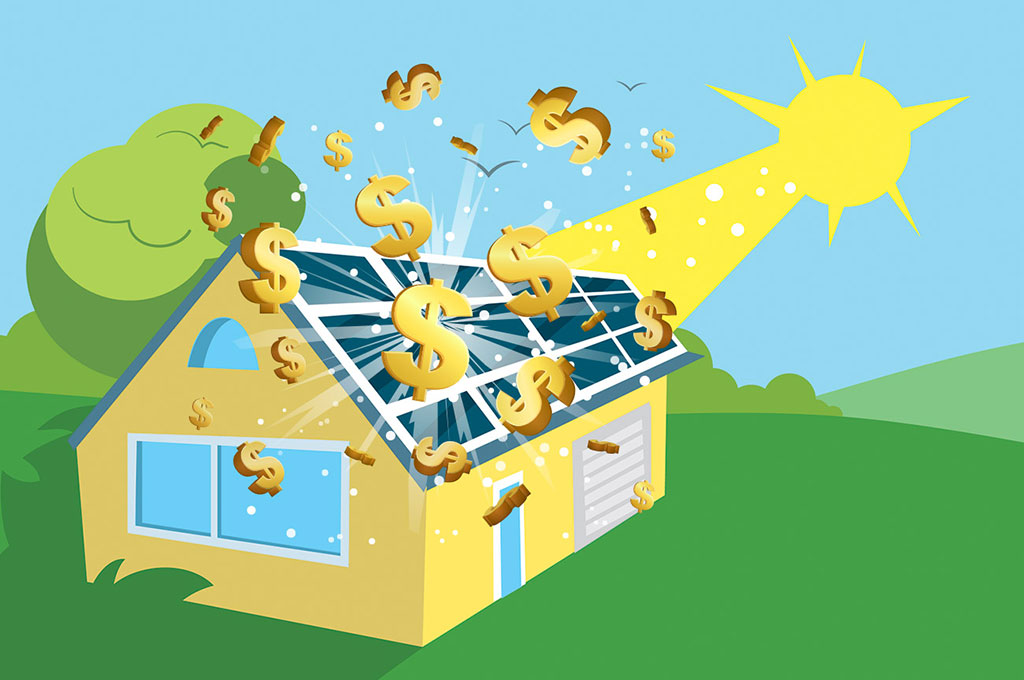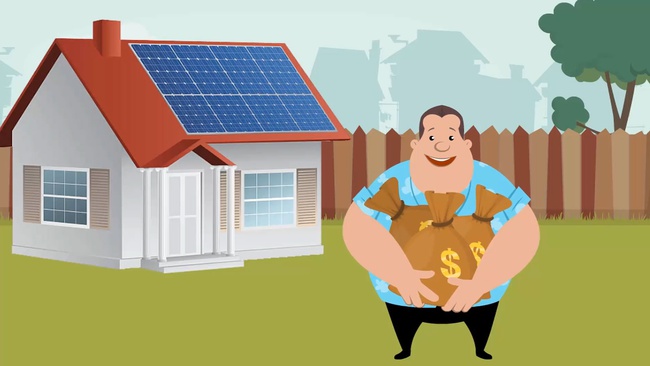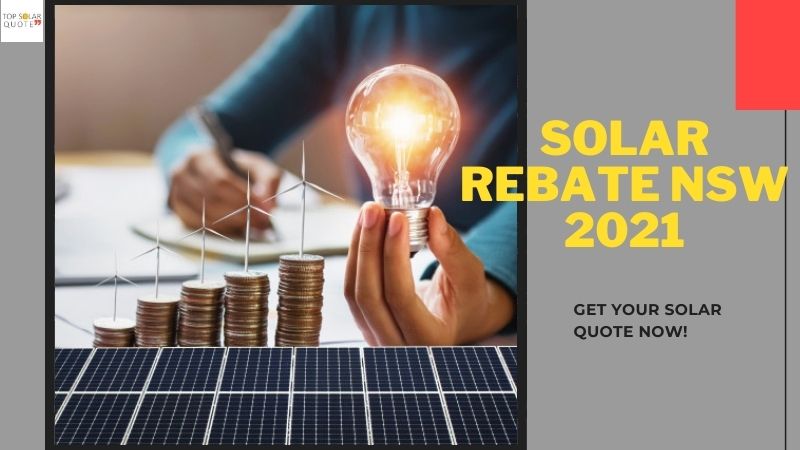The average rebate amount you can expect to receive on a solar system NSW can be approx $3,250.
Off course the rebate will depend on the size of the solar system you install. However the most common size of solar system installed in NSW is 5kW solar panels. [rebate offer of approx. $2,994]
Most of the people don’t know that location, size of the solar panels, and the current STC value are the three important things that can put emphasis on the rebate estimate in the open market.
All the above three factors hold a lot of importance in calculating solar rebates NSW which you will get to know as we will reach to the end part.
However before that have a glimpse on the below table of different rates of rebates [in approx] offered on different size of solar panels.
| Solar System size | Number of STCs | Government Rebate NSW | System Price After Rebate |
| 5kw | 76 | $2,994 | $4,450 |
| 6Kw | 91 | $3,585 | $5,166 |
| 6.6Kw | 100 | $3,940 | $5,570 |
| 7Kw | 106 | $4,176 | $5,684 |
| 10Kw | 152 | $5,988 | $7,890 |
Moving on get to know the above dynamics in brief, starting firstly with the term STC’s…
Book Your Solar Quotes To Get Best Deals At TopSolar!
#1: What Does STC’s Stands For In NSW?
The term stands for small-scale technology certificate solar scheme – an incentive programme to push Australians to opt more green energy production.
In basic words, the resident living either in Northern territories or the Outback may get slightly more STCs than those in New South Wales.
#2: What’s The Preferred System Size To Be Installed In NSW?
From the first table you can see – bigger the solar size the bigger the rebate, but it does not make any sense if you go for more than your need.
As per the reports the solar system size more in demand in NSW is a 6.6kW Solar Panel System. It is suitable for average house’s power needs.
Already said before that it does not mean that installing a smaller solar system will lead to disadvantage in terms of solar rebates.
Rebates are provided on the total cost of the solar system, and smaller ones will definitely have an equal rebate applied to cover the present cost.
Now coming to the main purpose of this blog which is to determine how much rebate you can get. For this keep your eyes on our next section.
How Much Of Rebate Can I Get On Solar System NSW?
The NSW Solar Rebate 2021 can be accessed at the federal level through both locally funded government STCs and STC’s schemes.
While you can’t expect the exact amount in rebates to be put down to a constant figure, but at least 50% of the cost processed for using one or both of the rebates by the solar installer.
Further to get a clear idea on the amount of rebate you can have in NSW, make sure that you enquire the solar sellers or installers on solar rebates available on solar products.
Also ensure to keep your eyes wide open for the updates from the Australian Clean Energy Council.
Another thing to consider is the time span of such rebates and incentives offers by the government. Thus let’s get to know that also,
When Does The Government Solar Rebate Programme Will Expire In NSW?
The STC-based Australian Government Solar Rebate will finish in 2030 as decided at the beginning of the project. By that time the government hopes to reach its green energy objectives and expects 100% solar products uptake in Australia.
This indicates the reducing rebates as we get each year closer to 2030, as illustrated in the chart below:
Apart from that these rebates are available to people only after they fulfil the basic eligibility criteria for solar rebates. Let’s get to know what they are!
Get The Flexible, Affordable And Differentiated Quotes – Book Your Appointment!
Is There Any Criteria To Qualify For Claiming Solar Rebate NSW?
Short answer is yes. In fact. It’s a good news for all those living within the borders of Australia. The NSW residents are entitled to both the rebates at federal level and also local solar rebates if they fulfil the requirements.
At present there are two solar rebates that you can qualify for being an Aussie and living in New South Wales and that is,
- Federal STC Rebates
- Rebate For Low-Income Households
Let’s dive in to know the criteria to get both of the above rebates.
#1. What Are The Requirements To Fulfil For STC Solar Rebates In NSW?

- You have to time your Solar system purchase and get installed within 12-months of applying for the certificates. Thus solar installs done a year ago to the time you claim the certificates are not eligible.
- The solar PV system meeting the quality standards set in Australia.
- The installation company accredited by the authorities. Additionally, the installer ensures to match up the requirements set out by the Clean Energy Council in Australia.
- Solar PV installation done as per the set guidelines of Clean Energy Council
- Compliance with the guidelines on safety set by federal and NSW authorities.
- Solar PV system installed should not be exceeding the nominal capacity of 100Kw and yearly output 250Mwh.
Thus if you are lucky enough to get accredited vendors your most of the above requirements can be met and you will be able to claim the solar rebate NSW.
Majority of buyers prefer to have those solar company who can handle the rebate and apply it to the point of discount on sale.
It saves you from the trouble of documentation and the lengthy, sometimes irritating, application process with the Clean energy council. Moving onto the second type of rebate available and its criteria.
#2. What Are The Requirements To Fulfil The NSW Solar Rebates For Low Income Households?

The NSW state-level solar incentive program is similar to the incentive programmes provided for the residents of Victoria and Australian Capital Territory enjoying for years.
As per the information drafted on the website of NSW government on Solar Energy Rebate NSW; this trial program is to support people with low incomes for installing solar panels.
Consequently this will also lead to reduction in their power bills. However till now it’s in vague up to what amount you can get the rebate.
Thus in order to know whether you can qualify for it or not check the below given criteria.
End Your Search For Best Solar Quotes Provider NSW… Tap On The Below Button.
Can I Get The NSW Solar For Low-Income Rebate?
To know whether you can get this rebate or not initiated by the NSW government, check down the listed eligibility factors.
- You should have a home in New South Wales
- Have a concession card from the Commonwealth Department of Human Services or Veterans’ affairs body in Australia.
- Any person in your family living on approved life-support machine in your home
- Has certain medical needs
- You are old age senior
- Hold a pensioner concession card from the Department of Veteran’ Affairs.
- no solar PV system installed at present in your home
- You have to give the proof of using at least 3,600Kwh of electricity in a year to claim the need for a solar system.
Adding on there are already pre-determined regions for Solar Low-Income Rebate In NSW. And they are as follows:
- The South Coast
- The North CoaST
- Illawarra- Shoalhaven
- Central Coast
- Sydney-South
The Applications for these state-level rebate are done through the aforementioned government Energy NSW website. Here the target is to offer solar rebates to at least 3000 households in NSW.
At the time of posting this statement, only two installers were approved to handle solar installations under NSW Solar Rebate For Low-Income Households.
Whereas the federal STC rebates does not holds such limit on access in Australia whether for the users or the installers.
Moving on if you are also going to install solar panels and fall for above rebate program check our next to discover the rebate amount you can have as discount.
What Is the Rebate Amount On 10kw Solar System NSW?
A rebate for a 10Kw system NSW is approx.. $5,988 based as per the current STC value and rates.
This value is generated assuming the installations of solar system with valid deeming period of 11 years and an STC valuation of around $39.40 per certificate.
To have more accurate figure, a chat with your dependable solar company will give you a clear view at the moment.
Alternatively, you can also use Solar Rebate NSW Calculator to calculate the number of STCs for a 10Kw Solar System in NSW using this formula:
Nominal Solar Panel wattage x deeming period x STCs zone rating.
For example, if you had install a 10Kw solar system in 2020, the STCs receive could have been calculated as follows:
10 x 11 x 1.342 =147.62 small-scale technology certificates.
Now to get the exact value multiply the number of STCs you got with the current STC value. For example, multiply 147.62 by 38.45 [current STC value] to get rebate around $5,675 in approx. So this is the final amount you receive as a discount for your solar installation after claiming STCs.
Make Your Solar Journey Easy And reliable With Top Solar !!
Okay so now you know all about the rebate programs and their claiming factor…but do you know the process of applying for such rebates?
Get the solution just after reading this line.
How Should I Apply To Get NSW Government Solar Rebate?
Basically there are two ways to apply for government solar rebates. The first one, preferred by majority of people, is about trusting over the solar company you dealing with to claim for your STCs rights.
After that they will be able to determine the rebate on the sale price as discount.
Coming to the second method here the work starts after the solar system installed.
Here you have to go through the document catering process by yourself. After that applying for the STCs with the Clean council through the online portal. Lastly trading for your STCs in the open market.
However in case of state-level rebates, like the Solar Rebate For Low-Income Households program, you have to apply for a separate application through the Energy NSW website.
Now we hope that you won’t find it difficult in applying for any kind of rebate program for solar in NSW. However before that we would also like you to know some of the disadvantages that persists with Solar Panel Installation NSW.
What Are The Disadvantages That Exist With Solar Energy?
No doubt in the fact that solar energy is still an attractive option for people in Australia. Also the Solar panels getting cheaper and cheaper, all regards to the NSW Government Rebates.
Moreover, the increasing energy costs and rates in New South Wales and other states are also making solar a complementary and sustainable source of energy for households.
Still , there are a certain laidback of using solar energy which are :
Inconsistent Daily Output
The Solar panels depend mainly on the amount of solar radiation it gets in a day or year to produce energy. But not always the weather patterns will work in your favor – as a result might affect your daily energy yields forcing to tap onto the grid for deficit.
Therefore to overcome this, invest in such solar system size whose nominal output exceeds your daily energy consumption.
For instance, if your daily consumption is slightly below or above the 25Kwh Mark, then a 6.6Kw solar installation will be more than enough for you in Sydney NSW.
Of course, you can go for an even bigger system along with battery storage to compensate for any inconsistencies [like power failure] in daily output.
The NSW homeowners can also have access to NSW Government Solar Loans from state under the programmes of Empowering Homes solar battery loan offer.
Initial Costs can Be Too Much
At most places, the price and installation cost of any size of solar system can actually be expensive. That’s why the Aussie government and other stakeholders are trying actively to make it cheap for you to install.
Further you can also get loan to cover amounts not covered in rebates. Also the payback periods for solar system are shorter in Australia (mostly less than 3 years).
Do I Need To Take The Approval Of Council To Install Solar Panels NSW?
You need to have the approval of the authorities to install solar panels at any place in Australia.
In various cases, bodies dealing with such energy and electrical installations need to act on the inspection of safety standards adhere. Especially when the installations done for grid connected residential places.
After going through the whole blog didn’t you felt that solar installations can really be a daunting task? Especially if you are not so techno friendly person!!
Book A Solar Quote And Get To Choose Among The Already Best Solar Installers At Your Nearby!
How about a person or company doing all such things for you? Is it possible? (You must be thinking)
Well our respond is yes… you don’t have to struggle so much to get solar panel installations done in a mannered way. You just have to book a quote at Top Solar Quote that too at best price.
Get A Free Customized Quote Today At Top Solar
We the people of Top Solar Quote have a team of experts who guides and gives best suggestions to the solar users.
The work of getting solar installations through a more professional Solar Installers NSW can really blow your mind, if things get worse.
Thus just to reduce that load from your brain we with our experience give our best in connecting you with the best of the Best Solar Panel Installers NSW at your nearby location.
And when we say the best that exactly what we mean! So gives us your first and last chance of proving ourselves right by signing up right now…
Get your free quote now!

